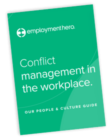Formal warning and disciplinary procedure for employees
What happens when employees are starting to underperform? Here are a few ways to keep your business compliant and teams on track.

Every business wants to be as productive and efficient as possible, and a large part of that involves having employees who are engaged and performing to a high standard. But what happens when you’re in a position where an employee is not meeting their duties or is actively being disruptive in the workplace? This is where disciplinary processes come into play. As a small business owner or HR professional, it’s important to make sure you understand disciplinary actions and have outlined processes in place. If you’re not sure where to start when writing a warning letter to an employee, keep reading as we break down warning and disciplinary procedures and give you a step-by-step guide to writing a formal warning letter. Disclaimer: This blog post does not constitute formal legal advice. This is intended as general information only. For formal legal advice, you must consult a lawyer. Employees should refer to their employment agreement or contact their employer for more information. Employers should also check any relevant industrial instruments or awards that apply to their employees and business.
What happens when employees start to underperform?
Poor-performing employees can have a negative effect on a business, for example:
- Unhappy customers or clients
- Decreased productivity
- High turnover
- Unmotivated and underperforming employees.
Looking at the above, it’s easy to see why a business may need to address poor performance with a formal warning procedure.
What is a formal disciplinary procedure?
A disciplinary process designed to deal with employee misconduct. All businesses should have a workplace policy in place that can be followed if necessary. It is recommended that small business owners or HR professionals outline this process in the employee handbook. There are different options for dealing with employee misconduct, and the way it is handled will depend on the severity of the transgression. The purpose of a disciplinary procedure is to ensure that employees reach the standards expected of them, both in terms of their behaviour and performance.
Why do businesses need a formal disciplinary process?
The purpose of having a disciplinary process in place is to regulate standards of conduct in the workplace and to provide mechanisms to correct unacceptable behaviour. There are several reasons as to why this is important:
Ensure fair treatment
It is essential to make sure that there is no unfair treatment in the workplace. Having guidelines in place prevents preferential treatment, and ensures that all employees are treated equally and based on their behaviour.
Provide opportunities to improve
Written warning procedures are one part of an entire disciplinary process. The goal is often to let an employee know that they need to improve their performance and give them an opportunity to do so.
Communicate expectations
Disciplinary actions also give employers the opportunity to clearly communicate their expectations. An employee warning letter outlines what will happen if no positive changes are made.
Protect the business
The goal is always to help an employee change their behaviour for the better, so they can continue working for the company. However, this is not always possible. In situations where an employee is dismissed, having an audit trail detailing the process you have taken prior to dismissal protects your business in the event a disgruntled former employee makes an unfair dismissal claim. Although disciplinary actions sound severe, they can be actioned for a couple of different reasons, such as underperformance and misconduct.
Employee performance issues
Employee performance issues include:
- Not carrying out their work to the required standard or not doing their job at all
- Not following workplace policies or rules
- Disruptive or negative behaviour at work, eg. toxic behaviour
All of these types of employee behaviour could warrant a formal written warning procedure to take place. Pro tip: To prevent underperformance from happening in the first place, you want to make sure you’re running regular performance reviews to make sure communication is always open between you and your employees.
Employee misconduct
Serious misconduct is when an employee:
- Causes serious and imminent risk to the health and safety of another person or to the reputation or profits of their employer’s business
- Unacceptable behaviour at work, eg. harassment or bullying
- Deliberately behaves in a way that’s inconsistent with continuing their employment.
Examples of serious misconduct can include anything from theft, fraud, assault or drugs and alcohol in the workplace.
Formal disciplinary process for employees
If an employee is not meeting the required standard of performance or is displaying signs of misconduct, business owners, managers or HR professionals may have no choice but to take disciplinary action. It’s important to try to resolve any issues informally first, and if there is no improvement, more formal actions will need to be taken.
Step 1: Informal verbal warning
The first step in any formal warning procedure is to try and resolve the issue informally. The best way of doing this is through verbal caution. Verbal warnings to employees can be used to advise a member of staff that they aren’t meeting the expectations of their role. While this isn’t a formal written warning procedure, you do need to detail the specific areas of underperformance and provide tangible examples for improvement. Performance issues should be flagged during regular one-on-one meetings, and written warning procedures should happen after other avenues have been pursued. After you have explained your concerns to an employee and provided them with strategies on how to improve performance, regular follow-up meetings should be held. These can be used as an opportunity to talk about progress. Regular catchups are also a chance to see if further help or support is needed, or to gain a deeper understanding about why an employee is underperforming. Where performance has improved, you should make sure to recognise this. If verbal cautions don’t garner any changes, you may want to move on to Step 2. Top Tip: Keep a note or email your employee following any verbal discussions you have about their performance. Doing this will make sure everything is clear. It also ensures that you have a written record of the topics that were discussed for future reference. It also provides an audit trail if an unfair dismissal claim arises in the future.
Step 2: Formal employee written warning procedure
A formal written warning procedure is a file that will sit on an employee’s record for future reference that outlines performance concerns and an action plan of what the employee needs to do to improve. Issuing an employee warning letter should come as no surprise to the employee, as it is not the first time you are discussing their performance. When you issue a formal employee warning letter, make sure you reference any verbal conversation that has previously been issued, along with the dates that they were issued. In formal employee written warnings, you should also:
- Specify details of the areas where your employees were, and still are, underperforming, and provide examples
- Create an action plan and communicate dates to check in with your employee
- Make sure it’s 100% clear that another letter could be issued or any other consequences (e.g. termination) if the employee does not meet your expectations
- Reassure your employee that the caution is completely confidential
Once the first written warning has been provided, we advise setting up another face-to-face meeting with your employee to discuss the letter in person. Tips for writing a caution letter:
- Outline the issues in your employees’ performance.
- Identify the changes you would like your employee to make, and the timeframe you would like to see improvement in.
- Be clear about the repercussions if adequate changes are not demonstrated within the assigned timeframe.
Employment Hero offers templates for formal written warning letters that are constantly reviewed by our Employment Specialists to help you get started. These templates also facilitate a paperless performance management experience where you can send the letter immediately after your meeting. This ensures your team member understands the areas for improvement with timelines and measures for delivery. Moreover, it’s added to their employee file for both your reference and their reference. Step 3: After the final written warning After issuing a written warning procedure, it is important to give the employee time to implement the relevant changes. In many cases, behaviour will improve and no further actions will be necessary. However, in some circumstances, underperformance may continue. If this is the case, employers have the right to act out the consequences previously outlined to the employee.
Step 4: Employee termination
Termination should only be considered as a final resort. You can see on the Fair Work website that; If an employee is terminated, the employer needs to make sure of the following for the employee in question:
- isn’t being unfairly dismissed
- is given the right notice of termination
- is given the right final pay
The employer may also think about getting independent advice from an employer association or lawyer if necessary.
Simplify formal warning procedures with Employment Hero
Misconduct in the workplace can come in many forms, from lateness and absenteeism all the way to more serious issues like harassment. It’s important that as an employer you take a formal and structured approach when dealing with employee misconduct. By doing this, you’re providing a clear message to your employees that unacceptable behaviour won’t be tolerated in the workplace. Employment Hero can take the stress out of formal warning procedures with a comprehensive For more information on employee termination, check out our quick and helpful guide to a company discipline and termination policy.
Related Resources
-
 Read more: Unauthorised Absence From Work: A Complete Guide
Read more: Unauthorised Absence From Work: A Complete GuideUnauthorised Absence From Work: A Complete Guide
Absences that aren’t authorised can disrupt productivity & morale. Learn to manage them effectively, comply with employment law & prevent…
-
 Read more: Automate HR Processes: 5 Key Processes You Should be Automating in 2025
Read more: Automate HR Processes: 5 Key Processes You Should be Automating in 2025Automate HR Processes: 5 Key Processes You Should be Automating in 2025
Automating HR processes is no longer a far-off future goal, it’s a strategic necessity. We’re diving into exactly why your…
-
 Read more: The Bradford Factor Explained: Assessing the Impact of Employee Absence on your Business
Read more: The Bradford Factor Explained: Assessing the Impact of Employee Absence on your BusinessThe Bradford Factor Explained: Assessing the Impact of Employee Absence on your Business
Managing absence in the workplace can be challenging, especially when it comes to spotting patterns that might affect productivity. The…












